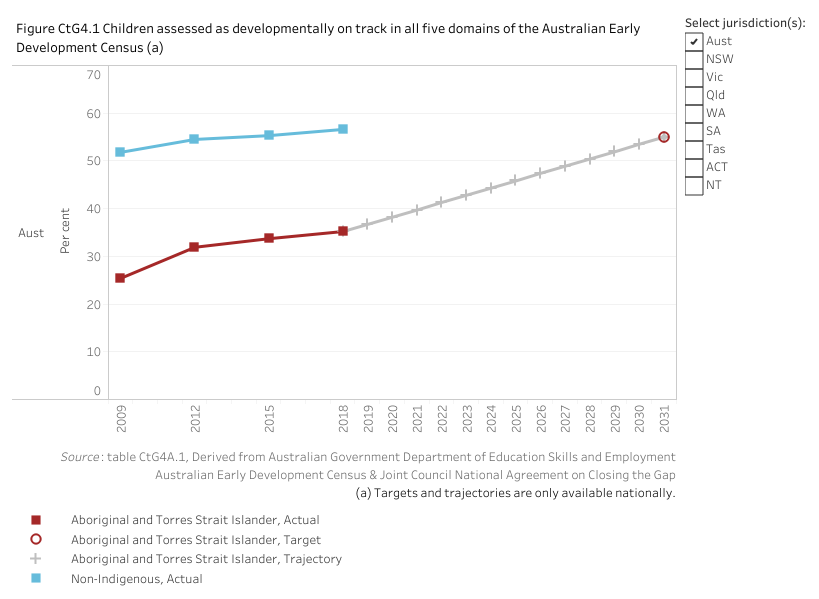TARGET 4
By 2031, increase the proportion of Aboriginal and Torres Strait Islander children assessed as developmentally on track in all five domains of the Australian Early Development Census (AEDC) to 55 per cent
Dashboard snapshot: The data below are the most recent at the time of preparing the July 2021 report. Please go to the dashboard to access the current data.
Nationally in 2018, 35.2 per cent of Aboriginal and Torres Strait Islander children commencing school were assessed as being developmentally on track in all five AEDC domains (figure CtG4.1).
There are no new data since the baseline year of 2018.

Target data specifications
Outcome: | Aboriginal and Torres Strait Islander children thrive in their early years. |
|---|---|
Target: | By 2031, increase the proportion of Aboriginal and Torres Strait Islander children assessed as developmentally on track in all five domains of the Australian Early Development Census (AEDC) to 55 per cent. |
Indicator: | The proportion of Aboriginal and Torres Strait Islander children assessed as developmentally on track in all five domains of the AEDC. |
Measure | The measure is defined as: Numerator — number of Aboriginal and Torres Strait Islander children in the first year of full-time schooling who scored above the cut off score for developmentally on track in all five domains of the AEDC. Denominator — total number of Aboriginal and Torres Strait Islander children in the first year of full-time schooling. and is presented as a percentage. |
Target established: | National Agreement on Closing the Gap July 2020 |
Latest dashboard update: | 23 June 2021 |
Indicator type: | Target |
Interpretation of change: | A high or increasing proportion is desirable. An increase from the baseline year is an improvement. |
Data source: | Name: AEDC microdata file. Frequency: Three-yearly Documentation (links): https://www.aedc.gov.au |
Data provider: | Provider name: Australian Government Department of Education, Skills and Employment Provider area: Australian Early Development Census |
Baseline year: | 2018 |
Target year: | 2031 |
Disaggregations: | State and territory and Australia, by Indigenous status |
Computation: | Numerator divided by Denominator multiplied by 100 Counting rules Children who score above the 25th percentile, determined using the cut-off points established in the first national census (2009 AEDC), are classified as ‘on track’. A set of cut-off points define on track for each of the five domains: physical health and well-being, social competence, emotional maturity, language and cognitive skills, and communication skills and general knowledge. Geographical variables are based on the location in which the child resides. As age is a factor contributing to children’s development, the published AEDC results control for age. Excludes (both numerator and denominator)
|
Data quality considerations: | See http://www.aedc.gov.au for further information. The AEDC is a national population measure on how children have developed by the time they start their first year of full-time school. Information is collected through a teacher-completed instrument in children’s first year of full-time schooling. For 2018, data were collected from 96.4 per cent of children in their first year of full-time school (308,953 children) of which 6.3 per cent were Aboriginal and/or Torres Strait Islander children. Of those not participating, 10.9 per cent were Aboriginal and/or Torres Strait Islander children. Of the 96.4 per cent of participating children, 4.9 per cent did not have domain scores calculated (8.1 per cent for Aboriginal and/or Torres Strait Islander children). Research conducted in 2007 validated the AEDC for use for Aboriginal and Torres Strait Islander children (AEDC Indigenous Adaption Study). The target year is 2031, however the AEDC is currently only collected every three years. The closest year to the target year that the AEDC is projected to be collected is 2030. |
Future reporting: | Additional disaggregations required for future reporting:
|
Supporting indicators
Driver
- Preschool attendance and enrolment
- Primary carer education level
Contextual information
- Outcomes by AEDC domains
Developmentally vulnerable, at risk, on track - AEDC Multiple Strengths Indicator
Highly developed, well developed and emerging strengths - Progress towards parity
